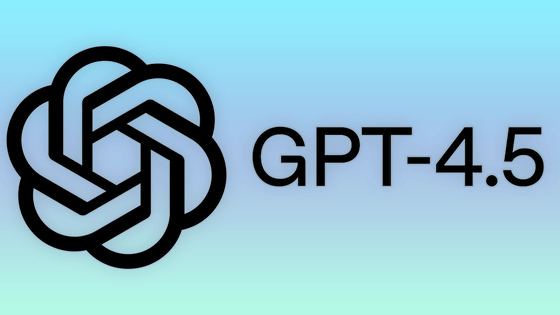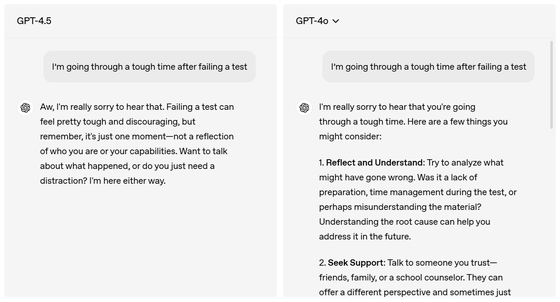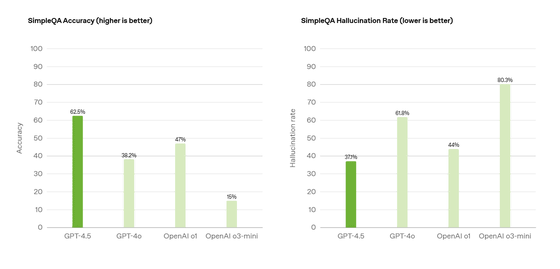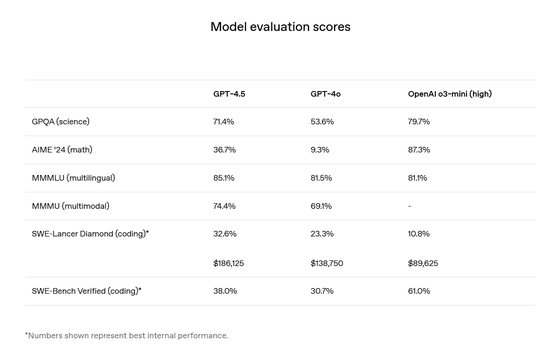OpenAI releases GPT-4.5, calling it 'the largest and best conversation model to date'

OpenAI released the large-scale language model ' GPT-4.5 ' on February 27, 2025. OpenAI evaluates GPT-4.5 as 'the largest and best conversational model, with a broader knowledge base and more natural dialogue,' emphasizing its superiority in practical applications.
Introducing GPT-4.5 | OpenAI
Introduction to GPT-4.5 - YouTube
GPT-4.5 is a model developed through pre-training and post-training scaling, which has improved its ability to recognize patterns, understand associations, and generate creative insights. Its basic approach is unsupervised learning, which learns patterns without explicit labeled data, allowing it to self-learn language patterns from large amounts of text data and generate answers intuitively.
OpenAI's o1 and o3-mini, which have already been released, are inference models that take a step of thinking before answering. In contrast, GPT-4.5 is specialized for unsupervised learning, so it does not have a step of thinking before answering and responds directly. OpenAI says that this is like 'instantly giving an answer based on past experience.'
The strengths of unsupervised learning are that it makes conversation more natural and fluent, it understands emotional nuances, and it has a broader knowledge base that can cover a wider range of topics, making it excellent for supporting creative writing and design.
Below, GPT-4.5 (left) and GPT-4o (right) are input with the words 'Failing the exam is painful.' GPT-4.5 empathizes with the user by saying, 'Oh, that's really unfortunate,' and makes a sympathetic comment, 'Do you want to talk about what happened? Or do you need a distraction? Either way, I'm here.' In response, the inference model GPT-4o states, 'I'm sorry,' and lists solutions such as 'Reflect on the test' and 'Talk to a friend, family member, or counselor.'

OpenAI focused on 'expanding computing power and data' in developing GPT-4.5. It said that it achieved more advanced language understanding by leveraging Microsoft Azure's AI supercomputers to provide as much computing power and data as possible and improve architecture and optimization.
A comparison of the accuracy (left) and

On the other hand, unsupervised learning models like GPT-4.5 have poor logical-solving abilities, such as solving complex mathematical problems, and their accuracy decreases when solving problems that require step-by-step logical development.
Below is a table comparing the results of various benchmarks performed on GPT-4.5, GPT-4o, and o3-mini (high). It becomes clearer that OpenAI o3-mini (high) is significantly superior to GPT-4.5, especially in tasks in the fields of mathematics and science. At the time of writing, the latest inference model, o3-mini (high), outperforms GPT-4.5 in GPQA (science), AIME '24 (mathematics), and SWE-Bench Verified (coding).

OpenAI believes that models that extend unsupervised learning such as GPT-4.5 will be the basis for better inference models and tool-utilizing agents, and predicts that in the future the two approaches of 'unsupervised learning' and 'inference' will complement each other. OpenAI positions the expansion of unsupervised learning as an exploratory approach that leads to 'discovery of unknown capabilities,' and suggests that it will continue to conduct research in this direction.
GPT-4.5 will first be released as a research preview to ChatGPT Pro users and the developer API, and will be gradually made available to Plus, Team, Enterprise, and Edu users from March 2025. However, because GPT-4.5 is a very large and computationally intensive model and is more expensive than GPT-4o, OpenAI does not guarantee long-term API availability.
Related Posts:
in Software, Posted by log1i_yk







